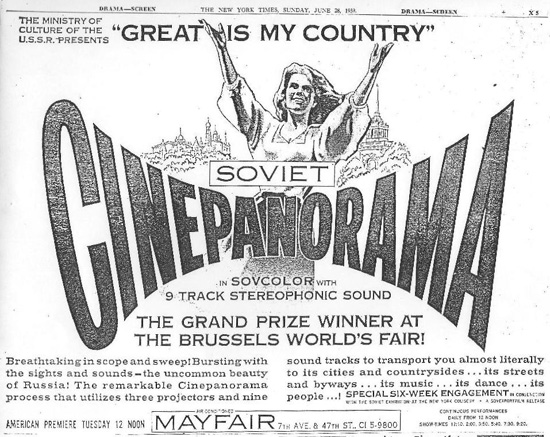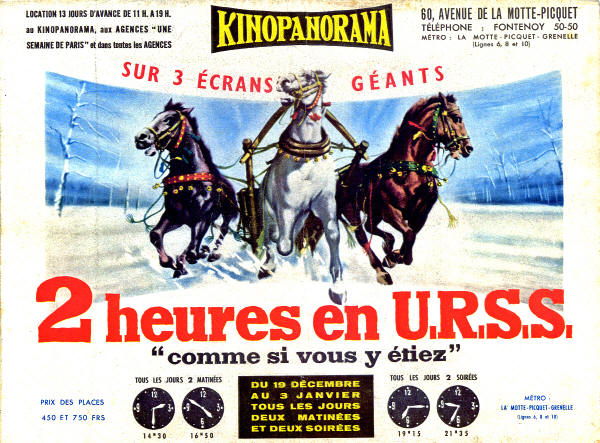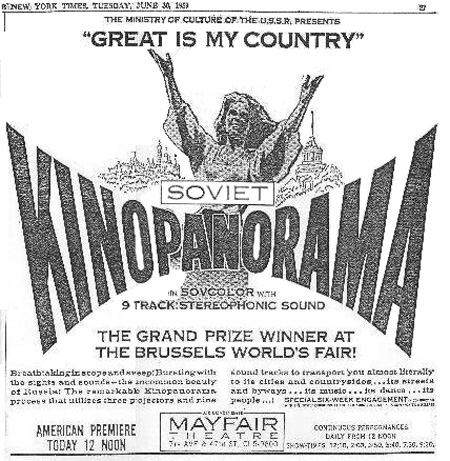"Great is my Country" in Kinopanorama |
Read more at in70mm.com The 70mm Newsletter |
| Written by: Gerhard Witte | Date: 03.12.2014 |
 The
Kinopanorama technology was developed between 1956 and 1957 by research
technicians at the “Scientific Research Cinema & Photo Institute” (better
known by its acronym “NIKFI”) in Moscow. The
Kinopanorama technology was developed between 1956 and 1957 by research
technicians at the “Scientific Research Cinema & Photo Institute” (better
known by its acronym “NIKFI”) in Moscow.A review of "Great is My Country" from New York Times, July 1, 1959: Technically, Kinopanorama is on a par with Cinemiracle. It has a lot of trouble with the match lines between the central panel and the two on the sides, and the central panel often is darker (or sometimes lighter) than the other two. But Sovcolor, the stock used, is excellent, and the nine-track stereo sound is first-rate. A good musical score, strong and jazzy, runs pretty much through the show. • Go to the Full review “Great is my Country” was the first Russian Kinopanorama film. It premiered on 28 February 1958 at the specially purpose-built “Mir Kino Theatre” in Moscow and was presented at the World Fair in Brussels in 1958 (EXPO, 17.04.1958 -19.10.1958), where it won a major award. |
More in 70mm reading: in70mm.com's Kinopanorama page Europe's Largest Panorama Cinema in Moscow • Kinopanorama Films • Kinopanorama in Paris • Lost Orphaned Film • Soviet Circular Panorama • Sovscope 70 • Cinemiracle/Cinerama in Germany • Cinemiracle/Cinerama in Deutschland |
 Advert
for "Great
is my Country" in New York, USA. "Great is my country/Vast is my Native
Land/Shiroka Strana Moya Rodnaya" originally premiered on 28.02.1958. Advert
for "Great
is my Country" in New York, USA. "Great is my country/Vast is my Native
Land/Shiroka Strana Moya Rodnaya" originally premiered on 28.02.1958.“Great is my Country” could be seen in New York at the Mayfair Theatre, opening on 30 June 1959 using 3-strip projection (Kinopanorama). “The Enchanted Mirror” ran at the same cinema from 21 July 1959 and both ran as a double-feature beginning on 3 August 1959. Details below.... |
|
 Announcement
for the KINOPANORAMA films which were shown in New York in 1959. Not
especially for "Great is my Country" Announcement
for the KINOPANORAMA films which were shown in New York in 1959. Not
especially for "Great is my Country"There were actually 2 Kinopanorama movies shown at the Mayfair during the Russian Trade Fair at the Coliseum - New York. "Great is my Country" from June 30th 1959 and "The Enchanted Mirror" from July 21st 1959 From August 3rd 1959. Those two movies were shown alternatively. The fact there was an intermission might be meaning the projectors were the Cinerama ones instead of the KINAP or may be the Russians did not want to send 6 projectors to this Expo. The two posters regarding "Two Hours in Russia" (2 Heures en URSS / Zwischen Nordpol und Krim) are not about "Great is my Country" but from the Extracts arranged by J. P. Mauclaire (France) for the Kinopanorama in Paris (Premiere in September 25th 1959) of the two movies: • "Great is my Country" • "The Enchanted Mirror" "Two Hours in Russia" was then shown in other European countries such as Germany and Italy and also Japan. |
|
 "2
Hours in the USSR" in Paris, France. This film is a double-feature with excerpts from the two Kinopanorama
films “Great is my Country” (Pokoriteli morya,
Shyroka strana moya rodnaya) and “The enchanted Mirror” (Volshevnoye
zerkalo). "2
Hours in the USSR" in Paris, France. This film is a double-feature with excerpts from the two Kinopanorama
films “Great is my Country” (Pokoriteli morya,
Shyroka strana moya rodnaya) and “The enchanted Mirror” (Volshevnoye
zerkalo). |
|
 “The
Soviet documentary-panorama film “Two Hours in the USSR” premiered on
Thursday at the West-Berlin “Capitol” Cinerama cinema, Berlin. It was renamed “Zwischen Nordpol und Krim”. The Soviet ambassador in the GDR, M. G. Perwuchin,
attended the premiere.” “The
Soviet documentary-panorama film “Two Hours in the USSR” premiered on
Thursday at the West-Berlin “Capitol” Cinerama cinema, Berlin. It was renamed “Zwischen Nordpol und Krim”. The Soviet ambassador in the GDR, M. G. Perwuchin,
attended the premiere.”Previously, the double-feature film, now titled “Deux heures en URSS” (Two Hours in the USSR), appeared for the first time at the only cinema outside the USSR built especially for Russian Kinopanorama films called "Kinopanorama" in Paris. The film was shown with great success on a curved 24 metre wide screen, using 3-strip projection with 9-channel magnetic sound. There were actually 6 Russian Kinopanorama projectors and 2 magnetic sound reproducers available in the projection room in order to allow a blended transition (without intermission) between the films. Full story here: • Cinemiracle/Cinerama in Germany • Cinemiracle/Cinerama in Deutschland |
|
Soviet's Costly B' Way Review
|
|
 "Great
is my Country" in New York, USA "Great
is my Country" in New York, USAFrom an article in "New York VARIETY" on 24.06.1959 about the expected premieres of two Russian Kinopanorama (Cinepanorama) films at the New York Mayfair Theatre. The Soviet Government is spending $500.000 on leasing the Mayfair Theatre on Broadway and on construction to equip the house to show two films in the Soviet Cinepanorama process. The show, timed to coincide with the Soviet Exhibition of Science, Technology and Culture at the N.Y. Coliseum starts June 30 with the film "Great is my Country". According to Victor Kalistratov, director of the Mayfair project and chief of the American section of Sovexport in Moscow, the Soviet Government is leasing the Mayfair for a period of 40 days at a cost of approximately $1.000 per day. House will charge $2.50 top. The second film to be shown at the Mayfair will be "The Enchanted Mirror", which is to have its premiere in late July. "Great is my Country" is the first Soviet picture to play on Broadway since 1943. The Cinepanorama process involves three projectors and utilizes a nine-track stereophonic sound system. It incorporates features of both Cinerama and CineMiracle. The Americans, in turn, will show Circarama at the American exhibition in Moscow later this summer. Kalistratov complained bitterly about the costs involved in equipping the Mayfair, but noted that this was due partly to the fact that the decision to show Cinepanorama on Broadway had been made late and in a hurry. Also, Mayfair was the only theatre available on Broadway for Soviet use. At the same time, the Soviet representatives felt he was being asked to pay well beyond original estimates. |
|
| Go: back - top - back issues - news index Updated 22-01-25 |
